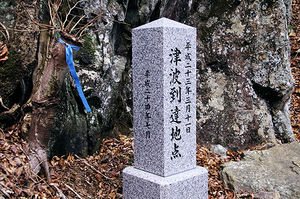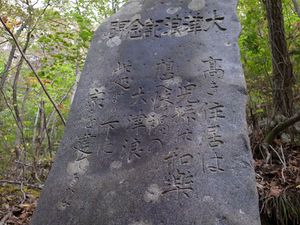Difference between revisions of "Tsunami warning stone"
(→Lack of information) |
|||
| Line 3: | Line 3: | ||
</ref>]] |
</ref>]] |
||
[[File:TsunamiWarningStone.jpeg|300px|thumb| |
[[File:TsunamiWarningStone.jpeg|300px|thumb| |
||
| − | [[Tsunami warning stone]] by |
+ | [[Tsunami warning stone]] by D.Lewis, and M.Fackler, 2015 |
<ref name="Danny">https://www.smithsonianmag.com/smart-news/century-old-warnings-against-tsunamis-dot-japans-coastline-180956448/ |
<ref name="Danny">https://www.smithsonianmag.com/smart-news/century-old-warnings-against-tsunamis-dot-japans-coastline-180956448/ |
||
Danny Lewis. |
Danny Lewis. |
||
Revision as of 14:56, 29 December 2018
Tsunami warning stone or Tsunami stone may refer to a stone monument, that indicates the highest level of other reached at tsunami, in order to warn the future generations.
Lack of information
The kanji at at the tsunami warning stone are believed to mean somethinf like
Beware of tsunami. Do not build homes below this level.
However, this is only guess, as the original text, written at a tsunami warning stone is usually not typed.
The text, suggested in the descriptions (even id the description is in Japanese) does not match the kanji written at the stone.
Several authors suggest images of various Tsunami warning stones.
These images are characterized in the following:
1. The authors do not type the original text written in the stones
2. The authors to not indicate the coordinates of the place, where the Tsunami warning stone is located.
These two observations repeat in many publications and can be considered as surely observed phenomenon.
Origin of this phenomenon can be subject of the scientific research. It is difficult to guess a honest reason, why an author (or the censor) would omit the most important information from the description of the image/
Scientific interest
The analysis of the tsunami warning stones, and, especially, the analysis of publications about them, represent certain scientific interest.
At it is mentioned, the most important information is usually omitted in the publications.
The lack of information about the Tsunami warning stone may have some economical reasons: the developers, who sell the ground below the Tsunami warning stones, or homes, or other constructions, that are built-up near the Ocean, below these stones, may be interested hi hide the information about the tsunami warning stones; both what is written there and where the stones are located.
It should be interesting to found other hypothesis, that explain the same phenomenon in any different way.
References
- ↑ http://iwashun.blog.fc2.com/blog-date-20130328.html 山田湾の北に重茂(おもえ)半島の姉吉(あねよし)地区があり、津波記念碑で有名になりました。 2013-03-28 その到達点に、昨年新たな石碑が建ちました。調査によれば、姉吉の津波溯上高は40.4メートル。従来の38.2メートルの更新であり、至上最高記録となりました。(2013年3月19日撮影) 2013年03月28日|いわて旬華愁凍
- ↑ https://www.smithsonianmag.com/smart-news/century-old-warnings-against-tsunamis-dot-japans-coastline-180956448/ Danny Lewis. These Century-Old Stone “Tsunami Stones” Dot Japan’s Coastline. “Remember the calamity of the great tsunamis. Do not build any homes below this point.” AUGUST 31, 2015. At the edge of Aneyoshi, a small village on Japan’s northeastern coast, a 10-foot-tall stone tablet stands, carved with a dire warning to locals. "High dwellings are the peace and harmony of our descendants," the rock slab says. "Remember the calamity of the great tsunamis. Do not build any homes below this point."// While the Aneyoshi tablet might be the most straightforward, so-called “tsunami stones” dot Japan’s coastline, warning the carvers’ descendants to seek high ground after earthquakes in case they foreshadow destructive waves. The stones vary in degrees of repair, with most dating back to around 1896, when two deadly tsunamis killed about 22,000 people, Martin Fackler writes for The New York Times. //
Keywords
Fukushima disaster, History, Japan, Tsunami, Tsunami Warning Stone

